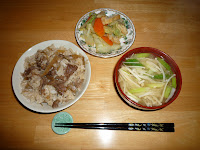Are ya ready for meat rice? If this meat rice doesn't knock your socks off I don't know what will. This is another one of my grandmother's famous maze gohan (mixed rice) recipes.
It's a sweet and savory combination of thin slices of meat, caramelized onions,
gobo cooked in a sweet soy sauce and mixed together with rice. I have such an urge to say "YUM-O" (watching too much Rachael Ray) but I'm gonna fight it.
Although there aren't a lot of ingredients in this dish, it does take some time to prepare. This might be something you can prepare on Sunday and have leftovers on Monday, maybe Tuesday and...
Ingredients for the Gobo Mix
2.5 cups of shredded gobo
1 teaspoon of sesame seed oil
1(1/2) cup of
dashijiru or water and 1/4 tsp. of dashi powder.
3 tablespoons of soy sauce
1 tablespoon of mirin
1 tablespoon of sugar
Ingredients for the meat
0.8 lbs (380 grams) of thinly sliced sukiyaki style meat or komagiri style meat.*
1.5 cups of dashijiru or water and 1/2 teaspoon of dashi powder.
1 onion sliced thinly
1/8 teaspoon of nutmeg
1 clove of garlic minced
4 tablespoons of soy sauce
1 tablespoon of mirin
1 tablespoon + 1 teaspoon of sugar
4 cups of rice washed.
1) Wash the rice and fill the water up until it's just below the four in the rice cooker.
2) Wash the gobo and
peel the skin using the back of your knife. (be careful not to touch your clothes after you handle gobo because it will stain your clothes)
3) Fill a large mixing bowl with water and add a teaspoon of vinegar to it. This is for
aku nuki. 4) Use a sharp knife or vegetable peeler and cut/peel half an inch to an inch long pieces of gobo into the vinegar water. Turn the gobo and shave off pieces of gobo as if you're sharpening a pencil. They should end up looking like wood shavings.
5) Cut your onions and mince the garlic.
6) Heat two frying pans.
7) Drain the gobo and add 1 teaspoon of the sesame seed oil to one of the hot pan and add the gobo. Stir fry for about 1-2 minutes stirring constantly with a wooden spoon.
8) In the other pan, add 1 teaspoon of vegetable oil and add the garlic and onions. Cook until the onions have caramelized.
9) Add the dashijiru, soy sauce, mirin and sugar to the gobo and simmer for 10-15 minutes.
10) In the garlic/Onion pan, add the meat and nutmeg and stir fry until it's half cooked.
11) Add dashijiru, soy sauce, mirin and sugar to the meat pan and simmer until the pink is gone. Turn the heat off immediately.
12) Ladle out half of the sauce from the meat and put it in the gobo pan. The gobo will have simmered down and have less sauce. Stir that around and continue to simmer the gobo for a few more minutes. The gobo should be cooked soft and about the same consistency as the rice. This is why you cook the meat (which cooks fast) and the gobo separately but you want the gobo to have a chance to absorb some of the delicious meat flavor.
13) One the gobo is done, you can combine everything back into one pan and allow all the flavors to marry. Don't simmer any longer.
14) When the rice switch goes off, allow the rice to steam in the rice cooker for about 5 minutes. Add the meat and gobo mix but only add about 1/4 cup of the sauce into the rice and don't mix. Allow everything to steam for an additional 10 minutes.
15) After 10 minutes, mix well and make sure everyhing is incorporated.
*Komagiri style meat is also thinly sliced but they are the scraps of thinly sliced pieces of meat.
Gobo shavings using a knife. You can use a vegetable peeler but you end up with a better thickness if you use a knife.


They should look like wood shavings.

The perfect piece.

Komagiri style meat comes packaged like this.

Stir fry gobo with vegetable oil.

Stir fry onions and garlic in another pan.

Add the gobo sauce ingredients and simmer.

Add the meat and nutmeg. This is how thin the meat is.

Add the meat sauce ingredients and cook until you don't see anymore pink and turn off heat immediately.

The sauce should simmer down but don't let all of it burn off.

Ladle in sauce from the meat pan.

Add some of the gobo sauce into the meat pan.

After the gobo is done, combine the gobo and meat and let the flavors marry. Leave the heat off.

Use tongs and put the meat and gobo mix into the rice cooker with 1/4 cup of sauce and allow it to steam for 10 minutes.

Mix well until all ingredients are incorporated.

Serve a nice heaping of rice into a big bowl.

Serve with vegetables and miso soup.





























































